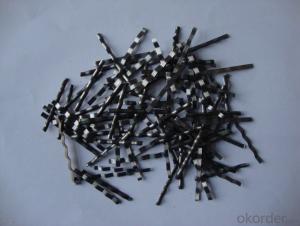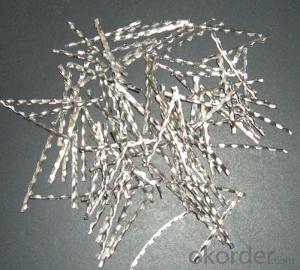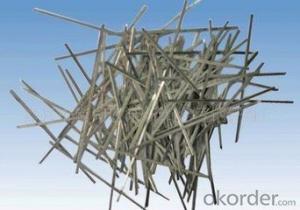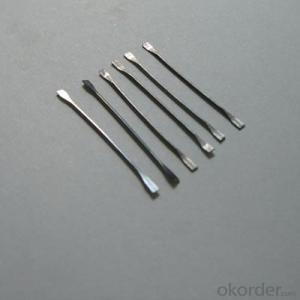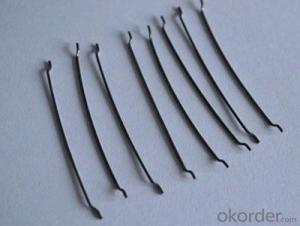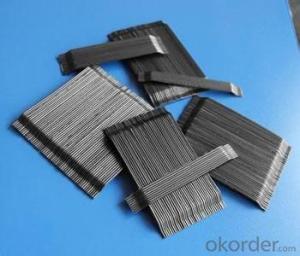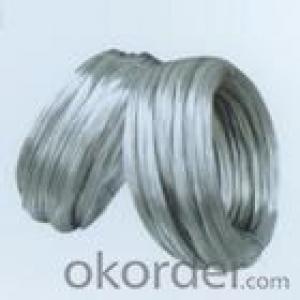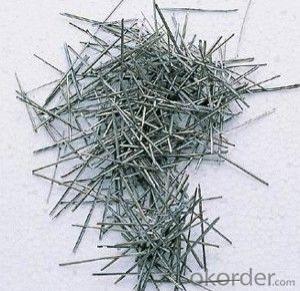Steel Fiber Copper Coated With Wire Diameter
- Loading Port:
- Tianjin
- Payment Terms:
- TT OR LC
- Min Order Qty:
- 1000 kg
- Supply Capability:
- 30000 kg/month
OKorder Service Pledge
OKorder Financial Service
You Might Also Like
Quick Details
Place of Origin: China (Mainland)
Model Number: HT-ST
Material: Steel
The Products
1>steel fiber
2>tensile strength: >1000Mpa
3>wire diameter:0.5mm-1mm
4>standard: ASTM A820
5>20 years factory
Specifications
Comparison of Steel fiber Reinforced Concrete and Ordinary Concrete
Item | Ordinary concrete | Steel fiber reinforced concrete | Enhancement rate |
C30(RC) | C30(SFRC) | (,%,) | |
Tensile strength | 3,5MPa | 5,39-7MPa | 54-100 |
Compressive strength | 31,2MPa | 32,5-40MPa | 4,4-28,2 |
Ultimate bending strength | 5,5MPa | 9,18-13,75MPa | 67-520 |
First crack bending strength | 4,88MPa | 7-8Mpa | 43-100 |
First crack strength | 8,85N,m | 23-53N,m | 160-500 |
Impact and fatigue strength | 5,96/cm2 | 53,3-91/m2 | 8-15 times |
Impermeability grade | P6~p12 | 0,5 ~2,5 times |
Reference for using the steel fiber reinforced concrete
Type of steel fiber reinforced concrete | length/mm | L/D |
For general purpose | 20~60 | 30~80 |
Jet concrete | 20~35 | 30~80 |
Joints of seismic frame | 35~60 | 50~80 |
Railway sleeper | 30~35 | 50~70 |
Layered composite pavement | 30~120 | 60~100 |
Proportion of steel fiber and concrete
Proportion for general projects:
Content of steel fiber | Sand percentage (%) | Water cement ratio | Slump (cm) | Unit amount (kg/m3) | ||||
Steel fiber | Cement | Gravel | Sand | Water | ||||
1—1.2 | 40 | 0.45 | 3—5 | 78 | 400 | 1233 | 819 | 180 |
Content of steel fiber | Sand percentage (%) | Water cement ratio | Slump (cm) | Unit amount (kg/m3) | ||||
Steel fiber | Cement | Gravel | Sand | Water | ||||
1.5—1.8 | 48 | 0.45 | 3—5 | 120 | 450 | 1210 | 1035 | 200 |
Picture
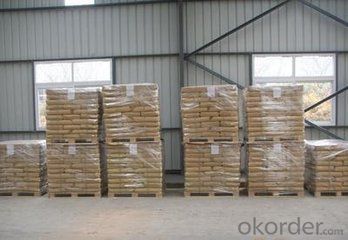
any type

pp bag
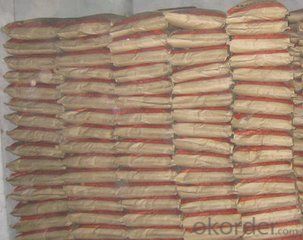
Steel fiber
FAQ
certificated: ISO 9001
Technical advantages of Daye steel fiber:
A. Improve mechanical performance of concrete
B. Provide uniform distribution throughout concrete with excellent mixing
C. No balling or caking by adopt correct mixing method
D. Reduce concrete volume
E.Save construction time and cost
F.Reduce excavation volume
G.Available for jointless floor.
- Q:What is the effect of melt extract stainless steel fiber on the impact resistance of concrete?
- The impact resistance of concrete is positively affected by the inclusion of melt extract stainless steel fibers. When these fibers are added to the concrete mix, they enhance the material's tensile strength and ductility, thereby increasing its resistance to impact and cracking. Acting as reinforcement, the fibers distribute the energy from an impact event throughout the concrete matrix, reducing stress concentration and preventing crack formation. Furthermore, the stainless steel composition of the fibers provides corrosion resistance, ensuring the long-term durability of the concrete structure. Overall, the addition of melt extract stainless steel fibers significantly improves concrete's impact resistance, making it a suitable choice for applications where heavy loads or potential impact events are anticipated.
- Q:Can melt extract stainless steel fiber be used in high-density concrete?
- Yes, melt extract stainless steel fiber can be used in high-density concrete. Stainless steel fibers are commonly added to concrete mixes to improve the overall strength, durability, and crack resistance of the concrete. The high-density concrete, which is typically used in applications where a denser and stronger material is required, can benefit from the addition of stainless steel fibers. These fibers help to reinforce the concrete and enhance its ability to withstand heavy loads, impact, and other stressors. Additionally, stainless steel fibers have excellent corrosion resistance properties, making them suitable for use in high-density concrete that may be exposed to harsh environmental conditions. Overall, the use of melt extract stainless steel fibers in high-density concrete can result in a stronger and more durable material that is better suited for demanding applications.
- Q:What is the effect of melt extract stainless steel fiber on the autogenous shrinkage of concrete?
- The addition of melt extract stainless steel fibers to concrete can significantly reduce the autogenous shrinkage. These fibers act as reinforcement, helping to distribute the internal stresses and restrain the shrinkage of the concrete. This leads to a decrease in the overall shrinkage of the concrete, resulting in improved durability and reduced cracking potential.
- Q:Can melt extract stainless steel fiber be used in roller-compacted concrete (RCC)?
- Yes, melt extract stainless steel fiber can be used in roller-compacted concrete (RCC). RCC is a type of concrete that is compacted using rollers, which provides a denser and more durable finished product. The addition of stainless steel fibers in RCC can enhance its mechanical properties, such as resistance to cracking and improved flexural strength. Melt extract stainless steel fibers are produced by melting stainless steel and then rapidly extracting it into fine fibers. These fibers have high tensile strength, corrosion resistance, and can effectively distribute stresses within the concrete matrix. As a result, they can enhance the performance of RCC by improving its resistance to shrinkage, impact, and fatigue. Furthermore, melt extract stainless steel fibers are easily dispersed in the concrete mixture and can be evenly distributed throughout the RCC during the compaction process. This ensures that the fibers are well-bonded with the concrete matrix, providing uniform reinforcement and preventing the formation of cracks. In summary, the use of melt extract stainless steel fiber in roller-compacted concrete is a suitable option to enhance its mechanical properties and overall durability. However, it is important to consult with concrete experts and conduct proper testing to determine the appropriate dosage and fiber length for the specific RCC application.
- Q:How does melt extract stainless steel fiber prevent plastic shrinkage cracking in concrete?
- Melt extract stainless steel fiber is a type of reinforcement material that is commonly used in concrete to prevent plastic shrinkage cracking. Plastic shrinkage cracking occurs when the concrete surface dries out too quickly, causing it to shrink and crack before it has fully hardened. The stainless steel fibers are added to the concrete mix during the mixing process. These fibers are extremely thin and have a high tensile strength, which means they can withstand high stress without breaking. When the concrete starts to dry and shrink, the stainless steel fibers distribute the stress evenly throughout the concrete matrix, preventing the formation of large cracks. The presence of these fibers also helps to reduce the overall drying shrinkage of the concrete. This is because the fibers create a network within the concrete that holds it together and limits the movement of the individual particles. As a result, the concrete experiences less shrinkage as it dries, reducing the likelihood of cracking. Additionally, the stainless steel fibers also improve the overall durability and toughness of the concrete. They enhance the resistance to impact, abrasion, and cracking, making the concrete more resilient and long-lasting. Overall, melt extract stainless steel fiber plays a crucial role in preventing plastic shrinkage cracking in concrete by providing reinforcement and reducing the overall shrinkage of the material. Its addition to concrete mixes helps to ensure that the concrete surface remains intact and structurally sound, even during the early stages of drying and hardening.
- Q:Can melt extract stainless steel fiber be used in pre-stressed concrete elements?
- Melt extract stainless steel fibers, known for their durability and excellent reinforcement properties, are suitable for pre-stressed concrete elements. By utilizing these fibers, the load-bearing capacity, crack resistance, and structural integrity of the concrete structures can be greatly improved. Moreover, the high tensile strength and corrosion resistance of stainless steel fibers make them perfect for environments with moisture or chemical exposure. Overall, incorporating melt extract stainless steel fibers in pre-stressed concrete elements can substantially enhance the structure's performance and lifespan.
- Q:What is the cost-effectiveness of using melt extract stainless steel fiber?
- The cost-effectiveness of using melt extract stainless steel fiber can vary depending on factors such as the specific application, project requirements, and the overall cost of the fiber itself. However, generally speaking, melt extract stainless steel fiber is considered to be cost-effective due to its durability, high tensile strength, and resistance to corrosion. These properties can result in reduced maintenance and repair costs over time, making it a cost-effective choice for applications that require reinforcement or enhanced durability.
- Q:Can melt extract stainless steel fiber be used in bridge deck overlays?
- Yes, melt extract stainless steel fiber can be used in bridge deck overlays. These fibers are commonly used in concrete applications to enhance the durability and strength of the structures. When used in bridge deck overlays, these fibers help in improving the overall performance and longevity of the bridge by reducing cracking and increasing resistance to wear and corrosion. Additionally, stainless steel fibers offer high tensile strength, allowing them to distribute loads more effectively and resist the movement caused by traffic and temperature changes. This makes them an ideal choice for bridge deck overlays where durability and long-term performance are critical factors.
- Q:How does melt extract stainless steel fiber contribute to the post-cracking behavior of concrete?
- The inclusion of melt extract stainless steel fiber is essential for improving the post-cracking behavior of concrete. These fibers, when added to the concrete mix, create a three-dimensional network within the matrix. This network reinforces the concrete and enhances its overall tensile strength. During the early stages of cracking, the fibers play a crucial role. They distribute the load and prevent the cracks from spreading. By bridging across the cracks, they maintain the structural integrity of the concrete. This is particularly important in situations where the concrete is subjected to dynamic or cyclic loading, as it prevents catastrophic failure. Additionally, melt extract stainless steel fibers significantly increase the ductility and toughness of the concrete. This means that even after cracking, the concrete can still deform without failing. It can absorb more energy before reaching failure. This improved post-cracking behavior allows the concrete to continue carrying loads and performing well, even under severe conditions. Furthermore, the stainless steel fibers also help to reduce the risk of shrinkage cracks in concrete. They restrain the tensile stresses caused by shrinkage, minimizing the formation and propagation of cracks during curing and drying. This is especially beneficial in large concrete structures and environments with varying temperature and moisture conditions. In conclusion, melt extract stainless steel fiber greatly enhances the post-cracking behavior of concrete. It increases tensile strength, bridges cracks, improves ductility, and reduces shrinkage cracking. The inclusion of these fibers ensures that concrete can withstand higher levels of loading, maintain its structural integrity, and exhibit superior performance, even after cracking has occurred.
- Q:How does melt extract stainless steel fiber improve the resistance of concrete to impact loads?
- The impact resistance of concrete is improved by the addition of melt extract stainless steel fiber in various ways. Firstly, the tensile strength and ductility of the concrete are significantly enhanced by the inclusion of stainless steel fibers. Acting as reinforcement, these fibers distribute the applied load more evenly throughout the concrete and reduce the concentration of stress points, thus preventing crack formation and propagation and increasing the overall impact resistance of the concrete. Furthermore, the unique properties of stainless steel, including high strength, corrosion resistance, and durability, contribute to the improved impact resistance of the concrete. The stainless steel fibers are extremely tough and can withstand high impact forces without breaking or deforming. This toughness allows them to effectively absorb and dissipate energy during impact, preventing catastrophic failure. In addition, the small size and high aspect ratio of the melt extract stainless steel fibers promote better bonding with the concrete matrix. This strong bond ensures that the fibers remain securely anchored within the concrete, even under high impact loads. Consequently, the overall strength and integrity of the concrete are increased, making it more resistant to damage caused by impacts. Moreover, the addition of stainless steel fibers can also enhance the behavior of concrete after cracking. In the event of cracks occurring due to impact loads, the fibers help to hold the cracked sections together, preventing further separation and limiting the extent of damage. This post-cracking behavior further contributes to the overall improvement in the impact resistance of the concrete. To summarize, melt extract stainless steel fiber improves the impact resistance of concrete by enhancing its tensile strength, ductility, and toughness. The fibers ensure a more uniform distribution of applied loads, prevent crack formation and propagation, and provide a strong bond with the concrete matrix. Additionally, they are capable of absorbing and dissipating energy during impact and contribute to the post-cracking behavior of the concrete.
1. Manufacturer Overview |
|
|---|---|
| Location | |
| Year Established | |
| Annual Output Value | |
| Main Markets | |
| Company Certifications | |
2. Manufacturer Certificates |
|
|---|---|
| a) Certification Name | |
| Range | |
| Reference | |
| Validity Period | |
3. Manufacturer Capability |
|
|---|---|
| a)Trade Capacity | |
| Nearest Port | |
| Export Percentage | |
| No.of Employees in Trade Department | |
| Language Spoken: | |
| b)Factory Information | |
| Factory Size: | |
| No. of Production Lines | |
| Contract Manufacturing | |
| Product Price Range | |
Send your message to us
Steel Fiber Copper Coated With Wire Diameter
- Loading Port:
- Tianjin
- Payment Terms:
- TT OR LC
- Min Order Qty:
- 1000 kg
- Supply Capability:
- 30000 kg/month
OKorder Service Pledge
OKorder Financial Service
Similar products
New products
Hot products
Related keywords
